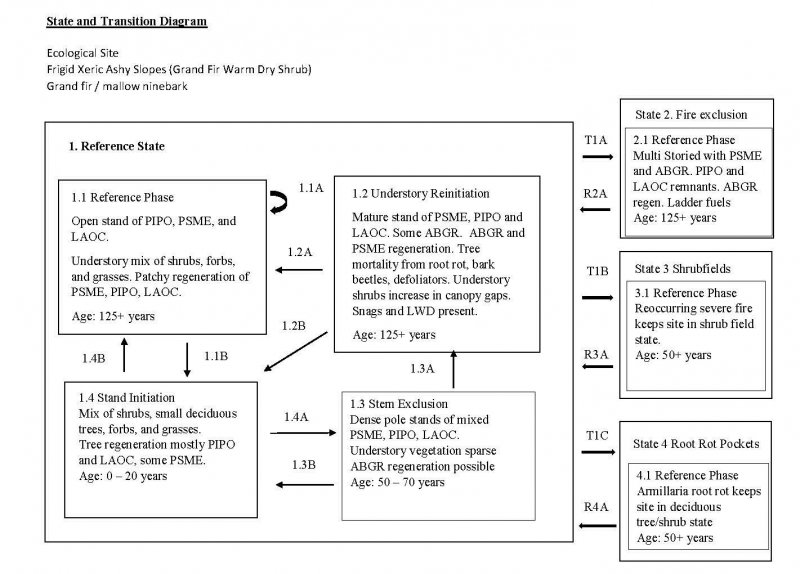
Natural Resources
Conservation Service
Ecological site F044AY503WA
Warm-Frigid, Moist- Xeric Loamy Foothills/Mountainsides, high water table (Grand Fir Warm Dry Shrub) Abies grandis - Pseudotsuga menziesii / Physocarpus malvaceus - Symphoricarpos albus
Last updated: 9/07/2023
Accessed: 12/19/2025
General information
Provisional. A provisional ecological site description has undergone quality control and quality assurance review. It contains a working state and transition model and enough information to identify the ecological site.
MLRA notes
Major Land Resource Area (MLRA): 044A–Northern Rocky Mountain Valleys
Major land resource area (MLRA): 043A-Northern Rocky Mountains
Description of MLRAs can be found in: United States Department of Agriculture, Natural Resources Conservation Service. 2006. Land Resource Regions and Major Land Resource Areas of the United States, the Caribbean, and the Pacific Basin. U.S. Department of Agriculture Handbook 296.
Available electronically at: http://www.nrcs.usda.gov/wps/portal/nrcs/detail/soils/ref/?cid=nrcs142p2_053624#handbook
LRU notes
Most commonly found in LRU 44A01 (Spokane-Rathdrum Outwash Plains). Also found in adjacent areas of 43A04 and 44A02.
Classification relationships
Relationship to Other Established Classifications:
United States National Vegetation Classification (2008) – A3362 Abies grandis – Pseudotsuga menziesii Central Rocky Mountain Forest & Woodland Alliance
Washington Natural Heritage Program. Ecosystems of Washington State, A Guide to Identification, Rocchio and Crawford, 2015 – Northern Rocky Mountain Mesic Montane Mixed Conifer Forest
Description of Ecoregions of the United States, USFS PN # 1391, 1995 - M333 Northern Rocky Mt. Forest-Steppe-Coniferous Forest-Alpine Meadow Province
Level III and IV Ecoregions of WA, US EPA, June 2010 – 15x Okanogan Highland Dry Forest, 15y Selkirk Mountains, 15v Northern Idaho Hills and Low Relief Mountains.
This ecological site includes the following USDA Forest Service Plant Association: ABRG/PHMA, (Williams et. al. 1995)
Ecological site concept
This ES group is distinguished by an overstory of grand fir and Douglas-fir and an understory shrub component of ninebark, oceanspray, snowberry and /or twinflower. It occurs on loamy foothills, and terraces that have a water table within 30 inches of the soil surface during the growing season. This ES group fits into the National Vegetation Standard’s Grand Fir - Douglas-fir Central Rocky Mountain Forest & Woodland Alliance and Washington State’s Natural Heritage Program’s Northern Rocky Mt. Mesic Montane Mixed Conifer Forest.
Associated sites
| R044AY501WA |
Mesic, Aquic, Organic Depressions and Seeps Found on floodplains and seeps at lower elevation. Confined to depressions and other areas of water accumulation; water table at 0 to 6 inches with mucky surface texture. Site vegetation is dominated by a mix of wetland adapted species including Spiraea, Alnus viridis , Carex, and Sphagnum |
|---|---|
| F043AY521WA |
Warm-Frigid, Moist- Xeric Loamy Foothills/Mountainsides, ashy surface (Grand Fir Warm Dry Shrub) Abies grandis - Pseudotsuga menziesii / Physocarpus malvaceus - Symphoricarpos albus Found on lower Hill slopes, mountain slopes and terraces. Textures are loamy and sites lack a high water table. The soil surface has a distinct layer of volcanic ash material. Overstory species include Abies grandis and Pseudotsuga menziesii var. glauca. The understory is typified by Physocarpus malvaceus, Symphoricarpos albus, Calamagrostis rubescens, and Hieracium albiflorum. |
| F043AY519WA |
Warm-Frigid, Xeric, Loamy Slopes, low AWC subsoils (Douglas-Fir/Warm Dry Shrub) Pseudotsuga menziesii / Physocarpus malvaceus - Symphoricarpos albus Sites are on warm, dry aspects of hills and mountains. They are usually less about 30 inches deep with abundant rock fragments in the profile. Surfaces have some weak volcanic ash influence. Overstory species include Pseudotsuga menziesii var. glauca, and Pinus ponderosa. The understory is typified by Physocarpus malvaceus, Symphoricarpos albus, Calamagrostis rubescens, and Bromus vulgaris. |
Similar sites
| F043AY522WA |
Warm-Frigid, Moist- Xeric Loamy Foothills/Mountainsides, mixed ash surface (Grand Fir Warm Dry Shrub) Abies grandis - Pseudotsuga menziesii / Physocarpus malvaceus - Symphoricarpos albus Found on hill and mountain side slopes adjacent to valleys. Lack a high water table. Overstory species include Abies grandis and Pseudotsuga menziesii var. glauca. The understory is typified by Physocarpus malvaceus, Symphoricarpos albus, Calamagrostis rubescens, and Hieracium albiflorum. |
|---|---|
| F044AY506WA |
Warm-Frigid, Xeric, Loamy, Foothills and Stream Terraces, High Water Table (Douglas-Fir Warm Dry Shrub) Found on lower warmer terraces and foot slopes having a water table within 20 to 30 inches of the ground surface in spring. Overstory species are Pseudotsuga menziesii var. glauca and Pinus ponderosa. The understory is typified by Symphoricarpos albus, Physocarpus malvaceus, Carex, and Calamagrostis rubescens. |
Table 1. Dominant plant species
| Tree |
(1) Abies grandis |
|---|---|
| Shrub |
(1) Physocarpus malvaceus |
| Herbaceous |
(1) Calamagrostis rubescens |
Click on box and path labels to scroll to the respective text.

